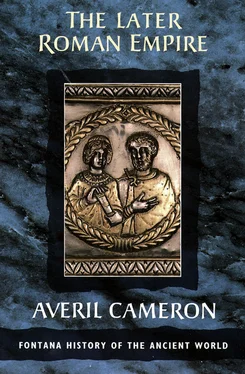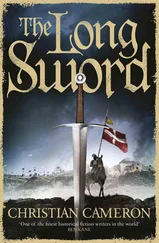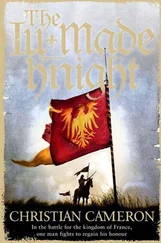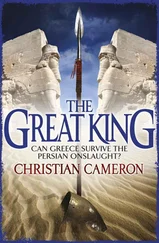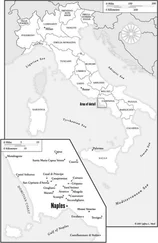1 ...7 8 9 11 12 13 ...16 Diocletian came to the throne in AD 284, having risen from a lowly background in Dalmatia to command the domestici , the imperial guard. He was thus one of the several Illyrian soldier-emperors who reached imperial power after the death of Gallienus in AD 268. The Emperor Aurelian (AD 270–5) had been able to repel an invasion of Italy by the Alamanni, defeat Zenobia at Palmyra and put an end to the ‘Gallic empire’ under Tetricus. Like Gallienus and so many others, Aurelian was murdered, but this time the assassins were punished, and Probus (AD 276–82) not only drove back the Germanic invaders from the Rhine, which they had crossed in force, but concluded a treaty establishing a Roman military presence beyond the Rhine and taking large numbers of hostages and recruits for the Roman army. When Probus too was murdered by his own troops, Carus (AD 282–3) embarked on a major and successful Persian expedition, only to die suddenly with the army on the Euphrates. His son Numerian led a Roman retreat, but when he too died under suspicious circumstances while on the road, Diocles was elevated at Nicomedia in November, AD 284, allegedly accusing his rival, the praetorian prefect Aper, of having murdered Numerian and stabbing him to death on the spot in full view of the troops, quoting from Virgil as he did so ( SHA Vita Cari 13); he then took the name Diocletian. In the following year Diocletian defeated Carus’s other son Carinus in a major battle in the former Yugoslavia and found himself in total control.
Even more pressing than the question of military security was that of how to put an end to the rapid turnover of emperors. Diocletian’s answer lay in the establishment in AD 293 of a system of power-sharing known as the tetrarchy (rule of four), by which there would be two Augusti and two Caesars, the latter destined in due course to succeed. Once established, the tetrarchic system lasted until it was destroyed by the ambition of Constantine, who had been raised himself on the death in AD 306 of his father, Constantius, who had first been made Caesar and then Augustus during the reign of Diocletian. Diocletian’s scheme did not come into being immediately on his accession. His first step was to raise another Illyrian soldier, Maximian, to the post of Caesar, at the same time adopting him as his son, though he was only a few years younger than himself (AD 285). An ad hoc division of responsibility gave Maximian the west while Diocletian was in the east; the fact that a certain Carausius had been declared Augustus in Britain no doubt influenced Diocletian to make Maximian Augustus in AD 286. Even then, the further step of appointing two Caesars was not taken until March, AD 293. Constantius and Galerius now became Caesars to Maximian and Diocletian respectively; the arrangements were sealed by dynastic marriages and the adoption of Diocletian’s family name Valerius, and advertised on coins and in official panegyric. Diocletian and Maximian, meeting formally at Milan in the winter of AD 290–1, had already affiliated themselves to the gods Jupiter and Hercules by taking the divine titles Jovius and Herculius, and their Caesars shared the same titulature and the same religious associations. As heir to his father Constantius, Constantine too is attested as Herculius in AD 307.
A porphyry statue group now to be seen as part of San Marco, Venice, shows the tetrarchs as squat figures in military dress, embracing each other. The surviving Latin panegyrics, like the Historia Augusta , emphasize unity and concord:
Four rulers of the world they were indeed, brave, wise, kind, generous, respectful to the senate, friends of the people, moderate, revered, devoted, pious. ( SHA Vita Cari 18)
Such heavy-handed propaganda betrays the fragility of the new arrangement: it rested on nothing more solid than consent. Carausius, who had seized power in Britain, was murdered and replaced by his rival Allectus in AD 293; Allectus was defeated in turn by Constantius in AD 296, who then entered London as a liberator ( Pan.Lat . 8(5)). Not that the defeat rewarded legality at the expense of usurpation, as the victors naturally claimed, for Carausius had been recognized as Augustus in Britain and north-west Gaul, and had issued coins in that capacity.
The propaganda, and the religious aura claimed for the tetrarchy, no doubt helped to impress their subjects, and to reassure Diocletian and his colleagues themselves, but it was in fact military, and by extension political, success which conferred legitimacy. Diocletian’s system remained in place only until it was challenged from within, after Diocletian himself retired in AD 305. Luckily for the empire, however, even though the tetrarchy was threatened in its early years by the regime of Carausius, it did ultimately succeed in providing a period of stability lasting nearly twenty years – long enough for some far-reaching changes to be introduced.
Any assessment of the nature of Diocletian’s reforms is rendered difficult by two factors: the unsatisfactory nature of the surviving literary evidence for his reign, and the fact that many individual changes either came in at a later stage, or are only attested later. Another problem is caused by the exaggerated contrast between Diocletian and Constantine which prevails in the sources; rather, Constantine’s secular policies, and even some aspects of his religious ones, should be seen as continuing the general line established by Diocletian.
One of Diocletian’s first priorities was military: not only had the army to be brought under central control and made into a force capable of defending the security of the empire, but it also had to be reliably supplied. The literary sources attribute to Diocletian the most fundamental changes that the Roman military system had experienced since the days of Augustus, and they have been followed by most modern scholars; however, it may be doubted whether the break with what had gone before was quite as sharp as this suggests. The way had already been prepared by earlier emperors, including Marcus Aurelius, Septimius Severus (AD 193–211) and Caracalla (AD 211–17). During their reigns army pay was doubled, donatives to the soldiers institutionalised, the army itself enlarged and openings for military men in the administration greatly increased. More units had certainly also been raised in the course of the third century. The hostile Lactantius associates the reforms of Diocletian with his establishment of the tetrarchy:
he appointed three men to share his rule, dividing the world into four parts and multiplying the armies, as each of the four strove to have a far larger number of troops than any previous emperors had had when they were governing the state alone. ( DMP 7.2)
But Lactantius can hardly be taken to mean that the army had quadrupled, especially as it is likely that it had already risen during the third century to something over 350,000. More probably this, like other remarks in the same chapter, is a hostile exaggeration, more a jibe than a sober estimate. Diocletian did perhaps increase numbers (new units were certainly created), but may not have done very much more in general than recognize and regularize the status quo. The backbone of the army had traditionally been the legions, well-armed and well-drilled units of about five thousand infantry. Reading back from the evidence of the Notitia Dignitatum (see above, Chapter II), Diocletian created new legions on a considerable scale, giving them names such as Iovia, Herculia, Diocletiana and Maximiana, while others had already come into being during the third century. But a large increase in the number of legions does not necessarily imply a doubling of the actual numbers of troops. Archaeological evidence drawn from the size of legionary fortresses and literary evidence both show that legions in the later Roman empire were much smaller than their predecessors, typically comprising only a thousand or so men, while special detachments ( vexillationes ) often stood at only five hundred or less; this implies that the calculations of total size based on earlier norms will be very misleading, and suggests that the actual total was considerably less than is often supposed.
Читать дальше
